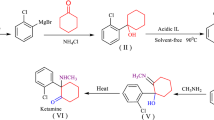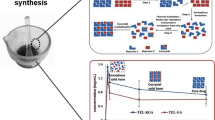Abstract
Citalopram, [(R,S)-1-[3-(dimethylamino)propyl]-1-(4-fluorophenyl)-1,3-dihydroisobenzofuran-5-carbonitrile] hydrobromide and its S-isomer, escitalopram oxalate, were analyzed regarding thermal degradation by TG/DTG–DTA, DSC, hot-stage microscopy and coupled TG-FTIR techniques. Citalopram presented a decomposition in a single step after melting at 189.3 °C (ΔHfus= 94.4 J g−1), without evidences of crystallization on cooling. Thermal techniques results combined with those from evolved gas analysis suggested decomposition via HBr, dimethylamine and fluorobenzene. Escitalopram presented a thermal degradation that started with the decomposition of the counter ion, after melting at 158.3 °C (ΔHfus= 106.2 J g−1), without evidences of crystallization on cooling followed by the release of dimethylamine and fluorobenzene. GC–MS of the residues confirmed the observations from the thermal analysis, but revealed several intermediates in the degradation of the racemate, probably due to the mixture of isomers. Differences in thermal behavior were attributed to differences in structure and counter ions. A tentative mechanism for their thermal behavior is proposed in both cases.











Similar content being viewed by others
Change history
18 May 2018
The structural formulas of the oxalic acid are incorrect in both Figures 1 and 6.
References
Jagtap A, Bhaskar M. Evaluation of antidepressant and antinociceptive activity of escitalopram. Ind J Pharm Edu Res. 2013;47:97–102.
Burke WJ, Christopher J, Kratochvil MD. Stereoisomers in psychiatry: the case of escitalopram. Prim Care Companion J Clin Psychiatry. 2002;4:20–4.
Balawejder M, Mossety-Leszczak B, Poplewska I, Lorenz H, Seidel-Morgenstern A, Pistkowski W, Antos D. Resolution of a diastereomeric salt of citalopram by multistage crystallization. Cryst Growth Des. 2012;12:2557–66.
Giridhar T, Srinivasa RK, Srinivasulo G, Gudipati S, Kotaru SR, Thota G. New crystalline form of citalopram diol intermediate useful for preparation of citalopram and its salt used as antidepressant drug. WO2010004575A2. 01/14/2010.
Pires SA, Mussel WN, Yoshida MI. Solid-state characterization and pharmaceutical compatibility between citalopram and excipients using thermal and non-thermal techniques. J Therm Anal Calorim. 2016;127:535–42.
Hotová G, Slovak V. Quantitative TG–MS analysis of evolved gases during the thermal decomposition of carbon containing solids. Thermochim Acta. 2016;632:23–8.
Nicolet-ThermoScientific Co. Nicolet EPA Vapor Phase database. Omnic 8.0 software. ThermoScientific, Madison.
Coblentz Society, Inc., “Evaluated infrared spectra” in NIST chemistry webbook, NIST standard reference database Number 69, In: Eds. PJ Linstrom, WG Mallard, National Institute of Standards and Technology, Gaithersburg, 20899, http://webbook.nist.gov (recovered at 11/10/2016). Coblentz No. 10480.
Coblentz Society, Inc., “Evaluated infrared spectra” in NIST chemistry webbook, NIST standard reference database Number 69, In: Eds. PJ Linstrom, WG Mallard, National Institute of Standards and Technology, Gaithersburg, 20899, http://webbook.nist.gov (recovered at 11/10/2016). Coblentz No. 8839.
Acknowledgements
The authors are grateful to agencies FAPESP (Processes: 2014/22142-4 and 2015/09299-4) and CNPq for support.
Author information
Authors and Affiliations
Corresponding author
Electronic supplementary material
Below is the link to the electronic supplementary material.
Rights and permissions
About this article
Cite this article
Pinto, B.V., Ferreira, A.P.G. & Cavalheiro, E.T.G. Thermal degradation mechanism for citalopram and escitalopram. J Therm Anal Calorim 133, 1509–1518 (2018). https://doi.org/10.1007/s10973-018-7226-7
Received:
Accepted:
Published:
Issue Date:
DOI: https://doi.org/10.1007/s10973-018-7226-7




